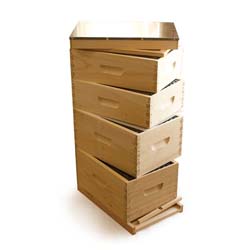Once you have a hive, you may be tempted simply to set where it’s the most convenient for you and your property, but there are many other aspects to consider before installing a beehive. The location of the hive I meant to provide the honeybees with the best environment possible. This means you must take into consideration every detail before making a final decision about a location for the hive. All the conditions need to be just right to ensure a healthy and successful colony of honeybees. View the following categories as a sort of checklist to keep track of the suitability of the location and determine where to place your hive from the results.
Light and Shade
Like most plants, bees need sunshine with periods of shade, but you need to be aware of the average temperature in the region you reside, as well as how much sunlight the different areas of your property get. If you live in a region that gets hotter than average, a shadier spot would be more beneficial to the bees, while regions that enjoy a cooler climate would call for the beehive to be in a spot that is exposed to sunlight for longer periods, allowing it to warm up sufficiently. The bees will give you a sign if they are too cold. They will form a cluster around the queen and beat their wings in an effort to generate heat. Regardless of the climate, the hive should be in a place where it will be warmed by the sun first thing in the morning to get the bees active.
Wind and Ventilation
The beehive should never be placed in a windy spot, but there are times when the weather deteriorates enough that no place is sheltered from the wind. In these cases, cover the hive and weight down the cover with cinderblocks or bricks. Straps can also be used in extreme weather to prevent damage to the hive. A little bit of wind is normal, but you should do your best to at least keep the entrance of the hive out of the path of the wind.
Ventilation of the hive is needed to aid in regulating the temperature of the hive. This is accomplished in numerous ways, and there is often a lively debate about the best ventilation methods among beekeepers. Some options include adding an extra entrance, buying specially made hive covers that regulate airflow, and installing battery operated thermometers that keep close track of the temperature inside and outside of the hive, alerting you to a temperature issue without disturbing the bees.
Water Source
Like all living things, bees need water to survive. An easy and reliable water source for bees is essential. Depending on your property, you may be near a lake, pond, creek, or stream, but that isn’t usually the case. You can solve the water source problem by installing a birdbath or setting out a container filled with water for the bees. It should be noted that the water source is not required to be elevated. The bees will find it wherever you place it.
It is also suggested that any manmade water source be shallow to avoid bee fatalities by drowning. This can be accomplished by filling the majority of the container with gravel or pebbles and filling it with just enough water to lap against the rocks, but not submerge them. The bees can easily gather from the pools of water or suck the moisture from the surface of the rocks.
Shelter
A bee shelter is necessary to help keep the beehive shielded from the elements and creatures that could harm it. A bee shelter is a relatively simple structure consisting of support beams, a roof, and walls on 3 sides, preferably made of latticework to allow sunlight inside the shelter, but not too much. The most important feature of a structure is that it should be raised in some manner. This could mean a fully constructed floor, or just a simple stack of concrete blocks. Either way, the beehive must be kept off the ground to deter rodents.
A shelter is often built by hand and there are various shelter designs to use as a guideline on the Internet. The important things are to keep out the rain, provide adequate sunshine and shade, and keep the beehive from touching the ground. Beyond those necessities, you can make your shelter look however you would like, but it might be helpful to do a bit of research before you begin.
Neighbors
As helpful as bees are to the human race, there is still a lot of negativity toward them. Unless you know your neighbors well, it is probably best to give them space when it comes to the bees. Keep the hive at least 25 ft. away from any property that is shared with a neighbor. Some neighbors may react in a paranoid fashion because of a preconceived prejudice toward the insects, others may have a legitimate health concern if they are allergic to stings, and others may be simply careless, as is the case with children. Due to these reasons, keeping a low profile as you tend your bees is suggested.
Pesticides
Generally, if you can avoid using them, then don’t, but there are times when an infestation needs to be treated or you could suffer the loss of flowers and/or other plants. In those instances, wait to spray the plants in the evening hours when it has cooled off outside and the bees are not active. You should only treat the areas that are necessary. Avoid spraying everything if not all the plants show signs of an infestation.
Try to buy pesticides that come in solution form or are degradable, which allows them to fade away quicker and be less toxic than traditional pesticides. Do your homework and find the pesticide that will rid your plants of that particular type of infestation the fastest and safest for your honeybees.
